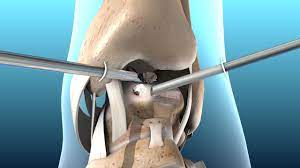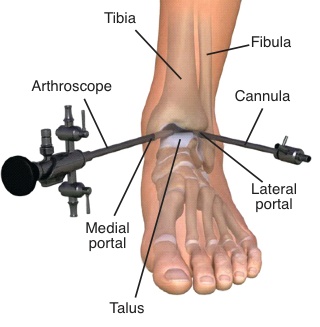Ankle arthroscopy is a minimally invasive surgical procedure that has been gaining popularity in recent years. It involves the use of small incisions and specialized instruments to examine, diagnose, and treat various ankle conditions. Despite being a relatively new technique, ankle arthroscopy has proven to be an effective alternative to traditional open surgery.
This comprehensive guide aims to provide readers with an overview of ankle arthroscopy, including its benefits, risks, and recovery process. Additionally, this article will explore the anatomy of the ankle joint and how it relates to the procedure. By understanding the intricacies of ankle arthroscopy, patients can make informed decisions about their treatment options and feel confident in their ability to recover successfully from surgery.
Table of Contents
An Overview of Ankle Arthroscopy
Ankle arthroscopy is a minimally invasive surgical procedure that enables orthopedic surgeons to visualize, diagnose, and treat various ankle conditions. It involves the insertion of a small camera, called an arthroscope, into the joint through small incisions. The camera provides real-time images of the inside of the joint on a monitor, allowing the surgeon to identify and address any issues.
There are several ankle arthroscopy techniques available depending on the specific condition being treated. These include diagnostic arthroscopy, synovectomy, debridement of damaged tissue or bone spurs, repair of torn ligaments or tendons, removal of loose bodies in the joint space, and fusion or replacement of joints as needed. As technology advances, future advancements in ankle arthroscopy may allow for even more precise diagnoses and treatments with less invasive procedures.
Understanding the Anatomy of the Ankle
The complex joint of the lower limb, situated between the tibia and fibula bones and the talus bone, is known as the ankle joint. The ankle joint plays a crucial role in weight-bearing activities and proper movement. It consists of several ligaments and tendons that provide stability to the joint.
The ankle joint is supported by three medial ligaments, namely; deltoid ligament, anterior tibiotalar ligament, and posterior tibiotalar ligament. These medial ligaments prevent excessive inversion or eversion movements of the foot. There are also three lateral ligaments – anterior talofibular ligament (ATFL), calcaneofibular ligament (CFL), and posterior talofibular ligament (PTFL). The ATFL is most commonly injured during an inversion injury to the ankle while CFL injuries are much less common. The PTFL provides stability to the subtalar joint which assists in inversion/eversion movements of the foot. Understanding these various structures that make up this anatomically complex region of our body is essential for performing successful arthroscopy procedures on patients with ankle problems.
Benefits and Risks of Ankle Arthroscopy
One important consideration when contemplating ankle arthroscopy is weighing the potential benefits and risks of the procedure. Ankle arthroscopy has several advantages over traditional open surgery, including smaller incisions, less tissue damage, faster healing time, and lower risk of infection. Additionally, ankle arthroscopy allows for a more accurate diagnosis as it provides a direct view of the joint through a small camera inserted into the ankle.
However, like any surgical procedure, ankle arthroscopy also comes with its own set of complications. These may include nerve damage during anaesthesia or surgery, blood clots in the leg veins (deep vein thrombosis), infection at the site of surgery, stiffness in the joint after surgery or persistent pain. It is important to discuss these risks with your doctor before undergoing this procedure so that you can make an informed decision about whether it is right for you.

Recovering from Ankle Arthroscopy Surgery
Rehabilitation after ankle arthroscopy surgery is a crucial aspect of the recovery process. The goal of postoperative rehabilitation is to promote healing, restore function and mobility, reduce swelling and pain, prevent complications, and improve overall quality of life. One important part of postoperative care involves performing specific exercises to help strengthen the muscles surrounding the ankle joint and regain flexibility.
Post-surgery exercises will typically begin within a few days after surgery and may include simple range-of-motion exercises, such as flexing and extending the foot or rotating it in circles. As healing progresses, more advanced exercises can be performed to improve balance, stability, endurance, and coordination. It is important to work closely with a physical therapist or healthcare provider to develop an individualized exercise program that meets your specific needs and goals. In addition to exercising regularly, managing postoperative pain through medication or other techniques can also aid in the recovery process by reducing discomfort during rehabilitation sessions.
Frequently Asked Questions
How much does ankle arthroscopy surgery typically cost?
The cost of ankle arthroscopy surgery varies based on several factors, including insurance coverage and financing options. Without insurance, the surgery can range from $5,000 to $15,000. Patients should explore financing options and discuss payment plans with their healthcare provider.
Can ankle arthroscopy be used to treat chronic ankle pain?
Ankle arthroscopy can be a useful tool for treating chronic ankle pain. Benefits include improved visualization and minimally invasive surgery. However, there are risks such as infection, nerve damage, and blood clots that must be considered.
Will I need to stay in the hospital overnight after ankle arthroscopy surgery?
Post-operative care for ankle arthroscopy typically involves immobilization, rest, and physical therapy. Discharge from the hospital usually occurs on the same day of surgery. Potential complications include infection, nerve damage, and blood clots.
How long does it typically take to fully recover from ankle arthroscopy surgery?
The rehabilitation timeline and post-operative care following ankle arthroscopy surgery depend on the severity of the injury, but typically patients can return to normal activities within a few weeks. Physical therapy may be necessary for several months for optimal recovery.
Are there any alternative treatments to ankle arthroscopy for ankle injuries?
Physical therapy and holistic remedies are alternative treatments for ankle injuries. These options focus on non-invasive methods of healing, such as exercises, massage therapy, acupuncture, and herbal medicine, and can be effective in promoting recovery and reducing pain.
Also read about The Perfect Harmony: Sweet Tea With a Twist of Lemon & Patient Education :- A Guide for Nurses and nurse leaders
Conclusion
In conclusion, ankle arthroscopy is a minimally invasive surgical procedure that offers numerous benefits over traditional open surgery. Surgeons can use this technique to diagnose and treat various ankle conditions, including ligament tears, cartilage damage, and bone spurs. However, patients must understand the potential risks associated with the procedure, such as infection and nerve damage.
Recovery from ankle arthroscopy typically involves rest, ice, compression, and elevation of the affected leg. Patients may also need physical therapy to regain strength and flexibility in their ankle joint. Overall, ankle arthroscopy can be an effective treatment option for individuals who are experiencing ankle pain or mobility issues. It is important for patients to consult with a qualified orthopedic surgeon to determine if they are a good candidate for this type of surgery.








